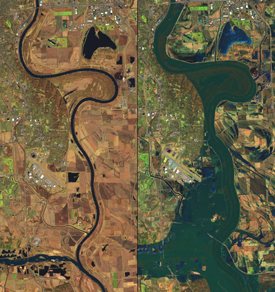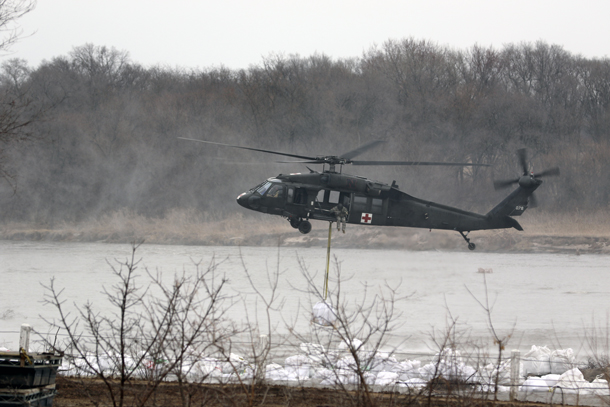Losing Ground: Midwest Floods Rip Away Topsoil
Air Date: Week of March 29, 2019

The Nebraska National Guard airdrop bales of hay to cattle who have been isolated by the floods across the Midwest. (Photo: Spc. Lisa Crawford, Nebraska National Guard, Flickr, CC BY 2.0)
Record flooding along the Missouri and Mississippi River basins is wreaking havoc on Midwestern farmers. Much of the soil where staple crops are grown has been washed away, threatening the livelihoods of farmers in the corn belt of the United States. Brian Kahn, senior reporter for Earther, joins host Steve Curwood to discuss the link between climate disruption and misfortune for Midwestern farmers.
Transcript
BASCOMB: It’s Living on Earth. I’m Bobby Bascomb.
CURWOOD: And I’m Steve Curwood.
The Midwest remains in a state of emergency with record flooding along the Missouri and Mississippi River basins. And for folks in Eastern Nebraska and other parts of the Corn Belt, the road to recovery will be especially hard. Climate disruption will continue to boost extreme weather events and much of the very soil that crops depend on has been swept away. The deep rich soils of the Great Plains helped make this land the breadbasket of the world. Now so much soil has been washed away in the floods that it could take years in some places before farmers can harvest those fields again even with the help of expensive fertilizers. And as if that weren’t enough growers have already lost income in the trade war with China, and flooding contaminated the grain some farmer had stored from last year, waiting for better market prices. Brian Kahn is a senior reporter for the Gizmodo website Earther and wrote about the lasting impact these floods will have on Midwestern farmers. Brian, welcome to Living on Earth!
KAHN: Thanks for having me.
CURWOOD: So what's going on?
KAHN: Well, these floods were a little bit different than the positive floods you can have, in part because they were so severe and extreme. When you have these smaller floods, sometimes they can wash that sediment in; it can be really helpful and beneficial for the soil. But what happened with these floods was something that was extremely different than that, for a number of factors. You gotta sort of go back a few months to actually understand what really happened, which is that it was an incredibly wet, cold winter in Nebraska. They had piles and piles of snow that had already actually fallen on top of tons and tons of rain that fell in the fall. So you had this really saturated soil, this thick layer of snow, and then you had, all of a sudden, this huge influx of rain a few weeks ago. When you get that rain falling on the snow, it melted it all off, and the soil was too saturated, so there was nowhere for it to go. And that's how we ended up with a massive amount of water basically scouring these fields. So instead of depositing nutrients, it basically ripped the nutrients out of the soil.

The Platte, Missouri, and Elkhorn are just some of the rivers that have been flooded in American Midwest after intense winter storms. The image on the right shows the affected area in March 2018, the image on the left shows the affected area in March 2019. (Photo: NASA Goddard Space Flight Center, Flickr, CC BY 2.0)
CURWOOD: And so of course there's a levee system now, so once the soil in the water, instead of getting spread out further downstream it gets channeled in these levees, huh?
KAHN: Yeah, I can get channeled in levees; you know, many of those levees also weren't even able to hold back the river. So you're having these big influxes of water actually be released from dams and levees that actually end up washing away more soil.
CURWOOD: By the way, Brian, remind us, just what is soil, as opposed to dirt.
KAHN: So soil is basically -- I mean, it's the building block of life. There's a reason the Midwest is the spot where we grow everything, it's because it's this incredibly dense, nutrient rich soil that allows all sorts of things that we rely on to eat, to grow. So that's why the Midwest is really this breadbasket of not just the U.S., but the world, because it has this soil that goes feet deep. And that is super dense in nutrients, and that allows plants to grow.
CURWOOD: So what are the options for flooded out farmers once the water recedes?
KAHN: I mean, frankly, none of the options are good. The first is to, you know, wait for the waters to recede, and see what that damage looks like. For fields that have been hit with just, you know, a little bit of flooding, and maybe a little bit of sediment and sandy soil, that can be churned up; it can be turned into, you know, farmable terrain, and they can grow something on that. May not be as big of a crop as last year, but it's something they can do. Another option is to think about soil remediation. So in some cases, we may be looking at sand that's, you know, a foot, two feet thick; this heavy sediment with no real nutrient value, or very little anyways. And in that case, what you're looking at is potentially years of remediation, so planting cover crops, doing things to help restore the structure of the soil that basically lets it hold nutrients again. And those kinds of processes are not short term. I mean, that's a multi-year process in a lot of cases, where you may have fields that just aren't producing anything to eat, or anything of you know, real value for years on end.
CURWOOD: To what extent did farmers lose stored crops that they were hoping to sell later on?
KAHN: I mean, that's happening all over the place; when your silos get filled with water, even the bottom bit, that can you create rot and all sorts of issues. And that's why, you know, when we're talking about what does this flood -- you know, what are the damages, what's the total going to cost? It's why we're not talking about, you know, hundreds of millions of dollars, we're talking about billions of dollars in losses within the agriculture sector, from not being able to plant; from having, you know, stored grain rot out; from having livestock die. I mean, you know, it's gonna reshape people's livelihoods, and it's going to reshape their considerations going forward.
CURWOOD: Now, in the aftermath of these floods, to what extent are some of these farmers going to be out of business?
KAHN: It's very possible that someone could very well declare bankruptcy or just want to walk away, because it comes to the point where their land is not worth the price it takes to grow things and input things, or those years of remediation just aren't worth it to them. And that speaks to a much bigger picture of what's happening, which is that, you know, farm production in certain areas has been declining for years; the tariffs that were recently implemented in the trade war with China by President Trump have also created a situation where you're looking at losses from agriculture. Some of those losses have been sort of met with state programs and with federal programs to help cut some of farmers' losses. But the reality is that those tariffs have, you know, sapped a billion dollars out of the agriculture industry in the Midwest. And so these farmers are already in a tight spot. And now they've been put in a much tighter spot, thanks to these floods.

The Nebraska National Guards airdrops sandbags in an effort to stem the flow of water after a diversion dam breach. (Photo: Army Staff Sgt. Koan Nissen, Nebraska National Guard, Flickr, CC BY 2.0)
CURWOOD: Sounds like the proverbial perfect storm. First, you have, well, fairly expensive fertilizers that you have to deal with, then you have this trade war with China and farmers not being able to sell their crops over the last year or so. And then you have this series of floods that just really wrecks everything from cutting this year's crop to nothing. I wonder if some of the farmers you talk to, if they're feeling like they're facing a plague or something?
KAHN: I mean, in a lot of ways it does, you know, sort of take on that biblical idea of a plague. I mean, it's just; it's wave after wave of things that are hitting them. To me, at least, as a climate reporter, it speaks in a lot of ways to the how climate change is kind of this idea of threat multiplier. You already have these people living in the Midwest that were dealing with, you know, pretty extreme impacts from the federal government pushing down on them; efforts to squeeze more out of their field, the use of fertilizer; I mean, all these different things kind of tugging and pulling at them. And then you have this, you know, final wave of this potentially climate change-induced storm and flood event happening. And that really pushes them over the edge. And so you know, this is a perfect example of, unfortunately, what we might see more as the world warms.
CURWOOD: Yeah, so you write that there certainly is probably a climate aspect to these floods there. So just how does climate change translate into worsening floods along these rivers and in this farmland?
KAHN: So one of the big things about climate change is that it's increasing both the commonness of extreme precipitation and the extremeness of that precipitation. And you know, this is also a basic physics thing at the end of the day, a warmer atmosphere holds more water; eventually, that water is going to fall out of the atmosphere. And so that's why we're seeing this increase in extreme precipitation around the US. And it certainly speaks to, you know, this storm in particular, you think about, sure it was cold in Nebraska, we're still gonna have cold winters. But we also are seeing this increase in rain falling during the winter, all across the country, including a 74% uptick in Nebraska, in terms of, if you look at weather stations around the state, 74% of them are recording more rain than they did even 50 years ago. And so, you know, this is what climate change looks like.
CURWOOD: So as climate driven catastrophes keep happening more and more frequently, people are talking about how important it is to be resilient. So what does resiliency mean for farmers at risk of continually losing their top soil, their stored grain and their livestock to floods?
KAHN: You know, I'd say that resiliency really sort of starts at the top. I mean what we're seeing here is, you know, a river control system that was designed for certain types of floods. And this flood was an outlier, it was extreme. It's kind of like, you look at what happened to New York during Hurricane Sandy. Or you look at what happened in California during the drought. I mean, these are outlier events that become more common. So we don't just need individual farmers to think about resiliency, we need to think about, how does the system itself become resilient? Frankly, there are no easy answers for what that looks like. Do you build more flood control dams? Do you build more levees? Or do you choose more natural solutions, to say, this area is now, you know, a floodplain that we're just going to not, not let anyone build? There are a lot of open questions on that. In terms of farmers and thinking about, you know, what can they do, there's a lot of talk about using cover crops to kind of keep soil locked in place even during the offseason; there are ideas around no-till agriculture, so farmers spend less time actually turning up their soil, and that will help the structure of the soil stay in place, should these heavy rain events occur. But yeah, really, this is like a whole system change that we need to talk about.
CURWOOD: Okay, Brian, I'm sitting down. So you can tell me... how much worse is this year's flood season projected to be like, do you think?

Brian Kahn is a science writer for Earther from Gizmodo Media and lectures at Columbia University. (Photo: Courtesy of Brian Kahn)
KAHN: Well, the damage right now in the upper Midwest alone is looking to be in the billions of dollars; early estimates have it pegged around $3 billion. That number is likely to rise. And there's also the reality that this flood season is not anywhere close to over. Even as the waters are receding in Nebraska and Iowa and that part of the upper Midwest, they're actually still surging downstream towards the Gulf of Mexico. And so you have a situation of flood forecasts for the coming few months through May that shows that there could be up to 200 million Americans at risk of facing floods. So the damages that we're seeing in the Midwest are actually unfortunately the tip of the iceberg of what we may see over the coming months.
CURWOOD: Journalist Brian Kahn lectures in the Climate and Society program at Columbia University. Brian, thanks so much for taking the time with us today.
KAHN: Oh, thank you for having me.
Links
Earther | “Farmers in the Midwest Face Decades of Recovery as Flooding Strips Away Crucial Soil”
Fortune | “Massive Flooding Has Destroyed Midwest U.S. Farms. Here’s What You Should Know”
Living on Earth wants to hear from you!
Living on Earth
62 Calef Highway, Suite 212
Lee, NH 03861
Telephone: 617-287-4121
E-mail: comments@loe.org
Newsletter [Click here]
Donate to Living on Earth!
Living on Earth is an independent media program and relies entirely on contributions from listeners and institutions supporting public service. Please donate now to preserve an independent environmental voice.
NewsletterLiving on Earth offers a weekly delivery of the show's rundown to your mailbox. Sign up for our newsletter today!
 Sailors For The Sea: Be the change you want to sea.
Sailors For The Sea: Be the change you want to sea.
 The Grantham Foundation for the Protection of the Environment: Committed to protecting and improving the health of the global environment.
The Grantham Foundation for the Protection of the Environment: Committed to protecting and improving the health of the global environment.
 Contribute to Living on Earth and receive, as our gift to you, an archival print of one of Mark Seth Lender's extraordinary wildlife photographs. Follow the link to see Mark's current collection of photographs.
Contribute to Living on Earth and receive, as our gift to you, an archival print of one of Mark Seth Lender's extraordinary wildlife photographs. Follow the link to see Mark's current collection of photographs.
 Buy a signed copy of Mark Seth Lender's book Smeagull the Seagull & support Living on Earth
Buy a signed copy of Mark Seth Lender's book Smeagull the Seagull & support Living on Earth

